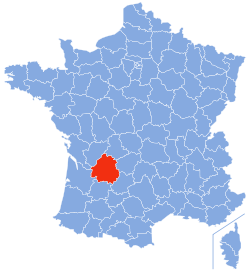
Back Dordogne (departemen) ACE Dordogne Afrikaans Département Dordogne ALS Dordonya AN دردنية Arabic Dordon Azerbaijani Дардонь (дэпартамент) Byelorussian Дардонь BE-X-OLD Дордон (департамент) Bulgarian Dordogne (departamant) Breton
Dordogne | |
|---|---|
 Prefecture building of the Dordogne department, in Périgueux | |
 Location of Dordogne in France | |
| Coordinates: 45°0′N 0°40′E / 45.000°N 0.667°E | |
| Country | France |
| Region | Nouvelle-Aquitaine |
| Département | 4 March 1790 |
| Prefecture | Périgueux |
| Subprefectures | Bergerac, Nontron, Sarlat-la-Canéda |
| Government | |
| • President | Germinal Peiro[1] |
| Area | |
| • Total | 9,060 km2 (3,500 sq mi) |
| Population (2014)[3] | |
| • Total | 416,350 |
| • Density | 46/km2 (120/sq mi) |
| Demonym(s) | Dordognots, Périgordins |
| Time zone | UTC+1 (CET) |
| • Summer (DST) | UTC+2 (CEST) |
| ISO 3166 code | FR-24 |
| Arrondissements | 4 |
| Cantons | 25 |
| Communes | 545 |
| Website | www.dordogne.fr |
Dordogne (Occitan: Dordonha) is a department in the southwest of France. It is named after the Dordogne river that runs through the department.
The department is in the region of Nouvelle-Aquitaine. It is between the valley of the Loire river and the Pyrenees. Its prefecture (capital) is Périgueux.
- ↑ "Le Président" (in French). Conseil départemental de la Dordogne. Archived from the original on 26 April 2017. Retrieved 8 March 2017.
- ↑ "Département de la Dordogne (24)". Comparateur de territoire (in French). Institut national de la statistique et des études économiques - INSEE. Retrieved 8 March 2017.
- ↑ "Populations légales 2014 des départements et des collectivités d'outre-mer" (in French). Institut national de la statistique et des études économiques - INSEE. Retrieved 8 March 2017.

